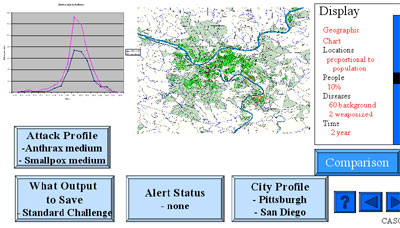BioWar:
A City Scale Multi-Agent Network Model of the Impact of Weaponized Biological Diseases
In trying to prepare for attacks, policy makers need to be able to think through the consequences of their decisions in various situations. Consider, for example, trying to decide if all US citizens should be vaccinated for smallpox. Speculations abound as to the potential devastation that smallpox could wreak. Medical experts, scientists, and policy makers need a way of thinking through the morass of complex interconnections to understand whether different inoculation or containment strategies will be effective. Unfortunately many existing models are quite limited in that they only apply to a single disease, discount factors such as the urban geography which can influence disease spread, or discount how people use their social networks (who is friends with whom) to pass information such as when to go to the doctor to be treated. In general, being able to estimating the impacts of large scale biological attacks and the efficacy of containment policies is necessary from an intelligence and planning perspective and requires reasoning about social response and disease processes as a complex social system.
 In BioWar we are combining state-of-the-art computational models of social
networks, communication media, disease models, demographically accurate agent
models, wind dispersion models, and a diagnostic error model into a single
integrated model of the impact of an attack on a city. Unlike traditional models
that look at hypothetical cities, in BioWar the analyst can examine real cities
using census, school track, and other publicly available information. Moreover,
rather than just providing information on the number of infections, BioWar models
the agents as they go about their lives - both the healthy and the infected.
This enables the analyst to observe the repercussions of various attacks and
containment policies on factors such as absenteeism, medical web hits, medical
phone calls, insurance claims, death rate, and over the counter pharmacy
purchases. BioWar moves beyond existing epidemiological models that do not
consider the heterogeneity of social networks and the geographical distribution
of people when predicting disease outbreaks.
In BioWar we are combining state-of-the-art computational models of social
networks, communication media, disease models, demographically accurate agent
models, wind dispersion models, and a diagnostic error model into a single
integrated model of the impact of an attack on a city. Unlike traditional models
that look at hypothetical cities, in BioWar the analyst can examine real cities
using census, school track, and other publicly available information. Moreover,
rather than just providing information on the number of infections, BioWar models
the agents as they go about their lives - both the healthy and the infected.
This enables the analyst to observe the repercussions of various attacks and
containment policies on factors such as absenteeism, medical web hits, medical
phone calls, insurance claims, death rate, and over the counter pharmacy
purchases. BioWar moves beyond existing epidemiological models that do not
consider the heterogeneity of social networks and the geographical distribution
of people when predicting disease outbreaks.
BioWar is an effort to develop a scaleable and precise simulation tool to examine disease propagation and agent behavior in response to disease and illness. We believe it will serve to help researchers understand, predict, and analyze weaponized biological attacks at the city level and engage in "what-if" analyses to help inform decision-making in this complex socio-technical policy domain. For example, it can be used in a "what-if" mode to examine the impact of and response to various weaponized attacks for contagious and non-contagious diseases under high-alert and no-alert conditions.
Version 2.1 has been tested on 3 cities, can handle 2.5 million agents and 2 years of interactions in 1 day of processing on a 4 processor system, and contains models of 60 diseases. Core modules include: City Generation, Social Network Generation, Agent Behavior, Disease (Transmission, Progression and Diagnosis), Weather (wind and climate), Attack Generation, Aerosolized Dispersion. Actual census, geographic, and behavioral information used as inputs. Outputs designed to reflect actual data streams for absenteeism, ER and Dr visits, OTC purchases, etc..
Version 2.2 had been optimized and tested on 5 cities.